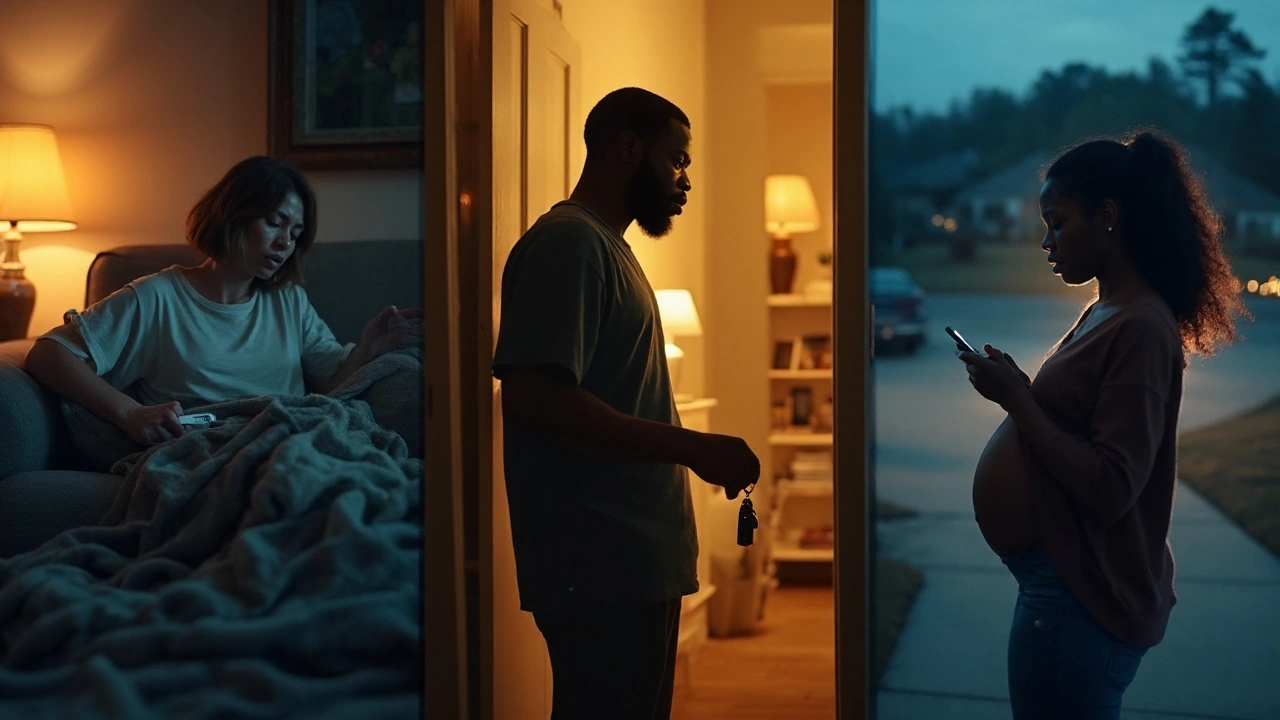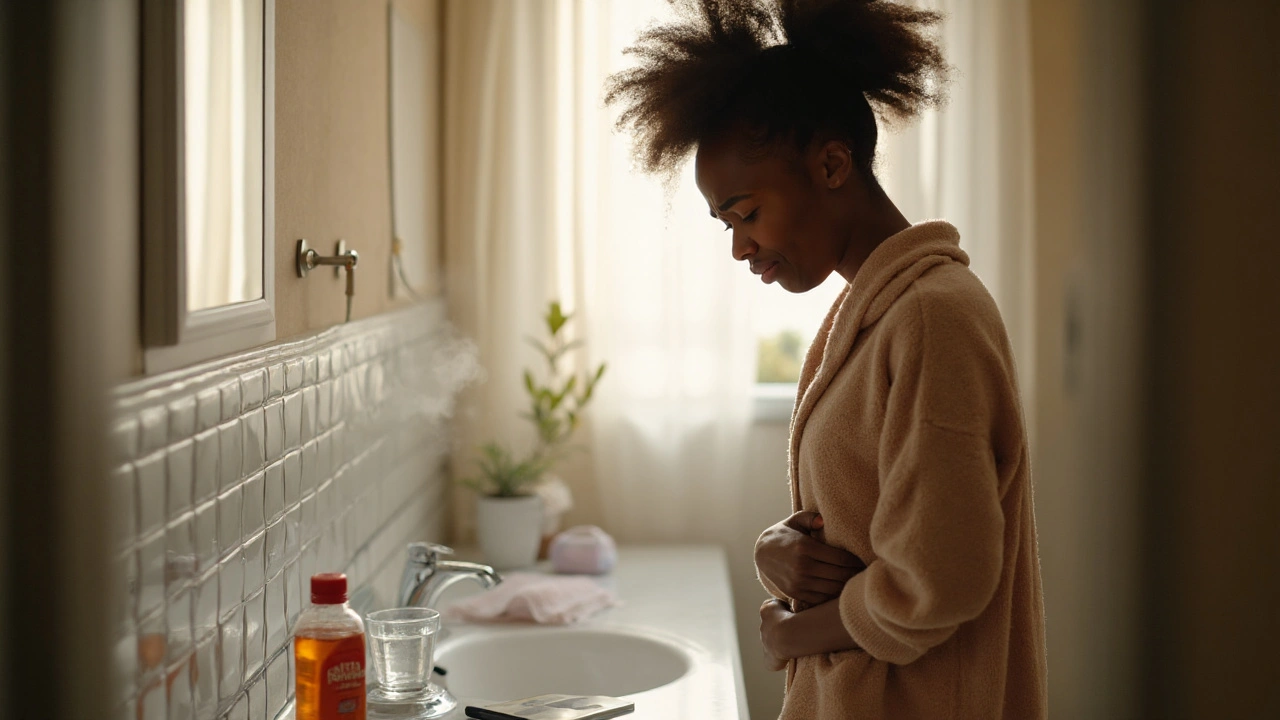That sharp, stingy heat low in your belly can feel scary. Is it a urinary infection, an STI, or something else entirely? The good news: most causes are treatable. The crucial bit is matching your symptoms to the right next step. We’ll sort the common culprits, the red flags you shouldn’t ignore, what you can try at home, and when to get medical care. If you’re dealing with a burning sensation in the pelvic area right now, you’ll find quick relief tips below-and a clear plan for what to do next.
Quick answers, red flags, and first steps (TL;DR + what to do now)
TL;DR:
- Most pelvic burning is caused by UTIs, genital infections (like thrush or bacterial vaginosis), STIs (chlamydia, gonorrhoea, trichomonas, herpes), skin irritation, or pelvic floor tension.
- Red flags: fever, severe pain, vomiting, pregnancy, back/flank pain, blood in urine, inability to pee, testicular pain/swelling, sudden one-sided pelvic pain, or feeling very unwell. Seek urgent care (call 111 in the UK for advice, 999/A&E for emergencies).
- Fast relief: hydrate, use simple pain relief (paracetamol/ibuprofen if suitable), avoid harsh soaps, sex, and irritants. For thrush, an antifungal; for suspected UTI, speak to a pharmacist or GP.
- Testing is your friend: urine dip/culture, STI NAAT swabs/urine, vaginal swabs, or prostate assessment depending on symptoms and sex.
- Treatments depend on cause: antibiotics for UTIs/STIs, antifungals for thrush, metronidazole for BV, pelvic floor physio for tension, topical oestrogen for menopausal dryness, neuropathic pain meds for nerve pain.
Do this now if you’re uncomfortable:
- Drink water regularly (aim straw-coloured urine). Don’t chug litres at once-steady sips are better.
- Take paracetamol or ibuprofen if you can use them safely. Check your usual contraindications.
- Avoid bladder irritants for 24-48 hours: caffeine, alcohol, citrus juices, very spicy foods.
- Skip scented soaps, bath bombs, douches, spermicidal gels, and tight non-breathable underwear.
- If you have vaginal itching and thick white discharge, use an antifungal (clotrimazole or one-dose fluconazole if suitable).
- If you think it’s cystitis (peeing often, stinging, lower belly discomfort), speak to a pharmacist/GP. In the UK, urine alkalising sachets (sodium/potassium citrate) may soothe temporarily, but they don’t treat infection.
- If there’s a chance of an STI (new or multiple partners, unprotected sex), avoid sex and arrange testing.
When to get help fast:
- Pregnant and you have UTI symptoms, fever, or pain.
- Fever (38°C+), vomiting, or pain in your back/flank (possible kidney infection).
- Severe pelvic pain, sudden one-sided pain, faintness, or shoulder-tip pain (ectopic pregnancy risk if you could be pregnant).
- Blood in urine, inability to pass urine, or you feel very unwell.
- Men: sudden testicular pain/swelling (possible torsion-emergency).
Why trust this approach? It’s aligned with guidance from the NHS and NICE (UK), the CDC (US), and the European Association of Urology-organisations that publish evidence-based advice on UTIs, STIs, pelvic inflammatory disease (PID), and chronic pelvic pain.

Causes and treatments mapped to your symptoms
Different patterns point to different causes. Use the lists below to narrow it down, then check the table for a side-by-side snapshot of likely tests and treatments.
Common in all adults
- Urinary tract infection (UTI)/cystitis: burning when peeing, frequent peeing, urgent need to go, lower tummy ache, sometimes blood in urine. Often no fever. More common in women. Tests: urine dip/culture. Treatment: short-course antibiotics as per local guidance; pain relief. If symptoms don’t settle within 48 hours or keep returning, see your GP.
- Kidney infection (pyelonephritis): pelvic or back/flank pain, fever, chills, nausea. Needs urgent GP/urgent care. Tests: urine culture, sometimes bloods. Treatment: antibiotics (often longer course or IV if severe).
- Genital herpes (HSV): burning pain, stinging, tender ulcers/sores, sometimes flu-like feelings at the start. Tests: swab of a sore. Treatment: antivirals; pain relief; salt-water baths; avoid sex until healed.
- Skin irritation/contact dermatitis: burning after new soap, lube, pads, shaving, tight clothing, or prolonged sweat. Look for redness or a raw feeling. Fix: remove irritant, switch to fragrance-free products, barrier ointment. If severe, see a clinician.
- Pelvic floor muscle tension: burning or pressure, worse after stress, sitting, or sex. Often normal tests. Treatment: pelvic floor physiotherapy, relaxation, heat, sometimes low-dose neuromodulators.
- Bladder pain syndrome/interstitial cystitis (BPS/IC): bladder/pelvic burning and pressure, needing to pee often, negative urine cultures. Treatment: bladder training, pelvic floor physio, symptom-targeted meds; specialist input if persistent.
Female-focused causes
- Vaginal thrush (candida): intense itch or burn, thick white discharge, soreness. Tests: often a clinical diagnosis; swab if recurrent or uncertain. Treatment: clotrimazole cream/pessary or single-dose fluconazole (if suitable).
- Bacterial vaginosis (BV): burning/irritation with thin greyish discharge and fishy smell, often after sex or period. Tests: vaginal swab. Treatment: metronidazole tablets or gel.
- Chlamydia/gonorrhoea/trichomonas: pelvic burning, discharge changes, bleeding after sex, pain with sex. Sometimes no symptoms. Tests: NAAT swab/urine. Treatment: antibiotics as per STI clinic protocols; partner treatment; avoid sex until cleared.
- Pelvic inflammatory disease (PID): pelvic pain/burning, fever, irregular bleeding, pain with sex, discharge changes. Often after untreated STI. Needs urgent assessment. Tests: pelvic exam, swabs, pregnancy test. Treatment: antibiotic combination and close follow-up; untreated PID risks fertility.
- Genitourinary syndrome of menopause (GSM): vaginal/pelvic burning, dryness, urinary urgency or recurrent UTIs in perimenopause/postmenopause. Treatment: vaginal oestrogen therapy, moisturisers, pelvic floor physio.
- Endometriosis: pelvic burning or cramping linked to periods, pain with sex, bowel/bladder symptoms during menses. Treatment: hormonal therapies, pain management, and sometimes surgery; specialist care.
- Early pregnancy complications: if pregnant or could be-burning with pain, bleeding, or one-sided pain needs urgent assessment to rule out ectopic pregnancy.
Male-focused causes
- Prostatitis: pelvic/perineal burning, aching in the lower back or groin, burning when peeing, sometimes fever (acute) or persistent discomfort (chronic). Tests: urine tests; prostate exam if appropriate. Treatment: antibiotics for acute bacterial cases, alpha-blockers, anti-inflammatories, pelvic floor physio for chronic cases.
- Urethritis (often STI-related): burning during urination, discharge, itching at the tip. Tests: first-void urine NAAT for STIs. Treatment: targeted antibiotics; partner testing/treatment.
- Epididymo-orchitis: scrotal pain/swelling with pelvic discomfort; sometimes STI-related in younger men, urinary bacteria in older men. Tests: urine, STI tests, scrotal ultrasound if needed. Treatment: antibiotics and support.
Less common but important
- Kidney/ureteric stones: severe colicky pain that can radiate to groin, burning when peeing if stone near bladder, blood in urine. Tests: urine, imaging. Treatment: pain relief, fluids, and sometimes procedures.
- Nerve-related pain (pudendal neuralgia): burning increased by sitting, reduced by standing. Treatment: physiotherapy, nerve-directed meds, specialist input.
- Dermatologic conditions: lichen sclerosus, psoriasis, eczema around the genitals can burn or sting. Treatment: dermatology-guided creams and care.
| Symptom pattern | Likely causes | First steps | Tests | Typical treatment/timeframe |
|---|---|---|---|---|
| Burning when peeing + urgency/frequency, no fever | Simple UTI (cystitis) | Hydrate, pain relief; speak to pharmacist/GP | Urine dip/culture | Short-course antibiotics; should improve in 24-48h |
| Burning + fever, back/flank pain, vomiting | Kidney infection | Urgent care | Urine culture, bloods; sometimes imaging | Antibiotics (often longer course) |
| Burning + thick white discharge, itch | Thrush (candida) | Antifungal cream/pessary; avoid irritants | Swab if recurrent/unclear | Antifungal; relief in 1-3 days |
| Burning + fishy odour, thin grey discharge | Bacterial vaginosis | See GP/sexual health clinic | Vaginal swab | Metronidazole tablets/gel; avoid douching |
| Burning + discharge or after new partner | STI (chlamydia, gonorrhoea, trich) | Avoid sex; get STI testing | NAAT urine/swabs | Targeted antibiotics; partner treatment |
| Burning + sores/ulcers | Genital herpes | Pain relief; salt-water baths | Swab of lesion | Antivirals; symptom control |
| Burning + new product/lube, shaving, sweaty clothing | Contact dermatitis/irritation | Stop irritant; barrier ointment | Clinical exam | Symptoms settle in days once trigger removed |
| Burning/pressure + negative cultures | BPS/IC or pelvic floor tension | Bladder diary; gentle stretches | Urine tests; specialist assessment | Physio, bladder training; ongoing management |
| Pelvic burn + irregular bleeding, pain with sex | PID or endometriosis | Prompt GP/clinic visit | Pelvic exam, swabs, pregnancy test | Antibiotics (PID) or hormonal/surgical options (endo) |
| Male pelvic burn + perineal ache | Prostatitis, urethritis | GP/clinic; avoid irritants | Urine tests; STI tests | Antibiotics if bacterial; physio for chronic |
Evidence snapshot: UTIs are among the most common bacterial infections in women; guidance from the NHS/NICE outlines short-course antibiotics for uncomplicated cases and warns to escalate if fever or back pain develops. STI screening with NAATs is recommended by sexual health authorities because many infections are silent. For chronic pelvic pain and bladder pain syndrome, multidisciplinary care-pelvic floor physiotherapy, bladder training, and pain modulation-gets better outcomes than medication alone, according to urology and gynaecology societies.

Self-care, prevention, checklists, and your next steps (with FAQ)
You don’t have to guess your way through this. Use the checklists below to prepare for an appointment, try safe relief at home, and spot when things aren’t following the usual pattern.
Quick self-care checklist
- Hydration: steady sips aiming for pale urine; don’t overdo it if you have heart/kidney issues.
- Pain relief: paracetamol or ibuprofen (if you can use them safely). Heat pack on the lower tummy can help.
- Genital care: wash with warm water only; fragrance-free emollient as a soap substitute if needed. Pat dry.
- Underwear: breathable cotton; avoid tight leggings while symptoms flare.
- Sex: pause until you’re comfortable and, if STI risk, until testing/treatment is complete.
- Short-term soothing for cystitis: urine alkalising sachets may ease sting (UK OTC), but they don’t cure infection; check meds if you’re on sodium-restricted diets.
- Thrush symptoms: antifungal cream/pessary; avoid douching or “intimate” washes.
- Bladder diary: track fluid intake, triggers (coffee, alcohol, spicy food), and urgency/pain to spot patterns.
When to seek routine vs urgent care
- Routine (24-72 hours): mild cystitis symptoms without fever; recurrent thrush; genital irritation that isn’t settling after removing triggers; persistent pelvic discomfort with negative tests.
- Urgent (same day): fever, back/flank pain, vomiting; pregnancy with urinary or pelvic symptoms; severe pain; visible blood in urine; new severe testicular pain/swelling.
What to bring to your GP or clinic
- Symptom timeline: when did the burning start, what makes it better/worse, any discharge, bleeding, fever, back pain, or sores?
- Sexual health details: new partners, condom use, last STI test.
- Period/pregnancy info if relevant: last menstrual period, contraception, chance of pregnancy.
- Past infections and treatments: recent antibiotics, recurrent UTIs or thrush.
- Products used: new soaps, pads, lubricants, shaving, tight clothing.
- Medications and conditions: diabetes, kidney issues, immunosuppression.
Prevention tips that actually help
- UTI prevention: pee soon after sex; don’t hold urine for long stretches; stay hydrated; consider vaginal oestrogen if postmenopausal (ask your GP); some find D‑mannose helpful for recurrent cystitis, though evidence is mixed-check with your clinician.
- Vaginal health: avoid douching and scented products; consider condoms if you get BV after unprotected sex; treat both partners for trichomonas.
- STIs: condoms, regular testing with new or multiple partners; seek treatment fast to prevent PID.
- Skin barrier: fragrance-free laundry detergent; a thin layer of barrier ointment before long runs or cycles if you chafe.
- Pelvic floor: if you clench when stressed, learn relaxation (diaphragmatic breathing, gentle stretches) and see a pelvic health physiotherapist if pain persists.
FAQ
- I have burning, but my urine test is negative. What now? Think pelvic floor tension, bladder pain syndrome, skin irritation, herpes (look for sores), or an STI not caught on a routine urine dip. Ask for NAAT STI testing and consider a pelvic health physio assessment.
- Burning after sex-why? Friction, latex or spermicide sensitivity, small tears, thrush, BV, or an STI. Try more lubrication (silicone-based if you’re sensitive), switch condoms/lube, and test for infections if the pattern repeats.
- Can I have a UTI without typical symptoms? Yes. Older adults may feel confused or off-balance; people with diabetes or on certain meds may have subtler signs. Testing helps.
- Do cranberry tablets work? Evidence is mixed. Some people get fewer UTIs; others don’t. They don’t treat an active UTI. If you’re on warfarin or have kidney issues, speak to your GP first.
- Is it safe to use vaginal oestrogen? For GSM, low-dose vaginal oestrogen is considered safe for most and has minimal systemic absorption, per gynaecology guidance. Discuss if you have a history of hormone-sensitive cancer.
- Prostatitis keeps flaring-what helps? Alongside antibiotics for acute bacterial cases, chronic symptoms often respond to a mix of pelvic floor physio, warm baths, anti-inflammatories, gentle activity, and stress reduction. A urologist can tailor a plan.
- Can anxiety cause burning? Stress can ramp up pelvic floor clenching and bladder sensitivity, making burning worse. Relaxation, breathwork, and physio can help alongside ruling out medical causes.
Troubleshooting by scenario
- After 48 hours on UTI antibiotics, still burning: Call your GP. You may need a different antibiotic based on culture, or a different diagnosis (BV, herpes, pelvic floor tension).
- Recurrent UTIs (3+ per year): Ask about a prevention plan-self-start antibiotics, post-coital antibiotics, vaginal oestrogen (if postmenopausal), behavioural tweaks, and checking for contributing factors.
- Persistent burning with no infection found: Consider bladder pain syndrome, vulvodynia, pudendal neuralgia, or pelvic floor overactivity. Ask for referral to a pelvic pain clinic and physiotherapy.
- Burning plus new discharge/odour: Treatable vaginal infections are likely-get a swab and avoid DIY remedies that disrupt the vaginal microbiome.
- Burning with sores or tingling: Get seen quickly for a swab; antivirals work best when started early.
- Men with burning at the tip + discharge: Don’t wait. Arrange STI testing and avoid sex until treated.
How clinicians usually investigate
- History and exam focused on urinary, genital, and pelvic floor symptoms.
- Urine dip and culture when a UTI is suspected; don’t rely on dips alone if symptoms are strong.
- NAAT testing for chlamydia and gonorrhoea; trichomonas testing if relevant.
- Vaginal swabs for thrush and BV if discharge is present.
- Pregnancy test if there’s any chance-this guides urgency and next steps.
- Targeted imaging (ultrasound/CT) if stones, torsion, or appendicitis are in the mix.
- For persistent pain: pelvic floor assessment, bladder diary, and sometimes cystoscopy or specialist referral.
Medications mentioned (speak to a clinician/pharmacist about suitability): paracetamol, ibuprofen, nitrofurantoin/trimethoprim (UTIs, guided by local resistance patterns), metronidazole (BV), clotrimazole/fluconazole (thrush), aciclovir/valaciclovir (herpes), doxycycline/ceftriaxone (some STIs), alpha-blockers (prostatitis symptoms), low-dose amitriptyline/gabapentin for chronic pelvic pain, topical vaginal oestrogen for GSM.
Source credibility: Recommendations in this guide reflect consensus from the NHS and NICE (UK antimicrobial and pelvic pain guidance), UK sexual health protocols, CDC STI treatment guidelines, the European Association of Urology, and the Royal College of Obstetricians and Gynaecologists. Local practice varies-your GP or sexual health clinic will tailor to you.
Your next step: If symptoms are mild and no red flags, try 24-48 hours of the self-care steps above and arrange testing if not improving. If any red flag applies, don’t sit on it-seek urgent care. Either way, a clear note of your symptoms and triggers speeds up the right treatment.


Brian Pellot
Drink plenty of water and see a GP if it gets worse.